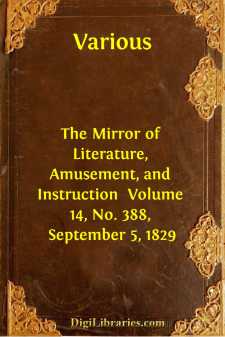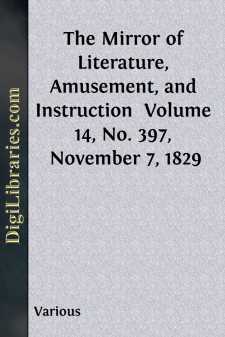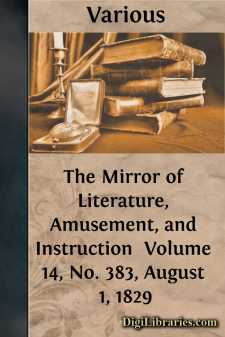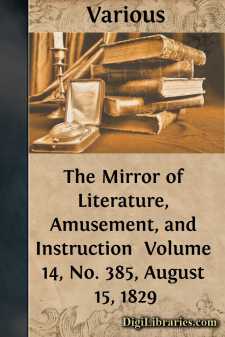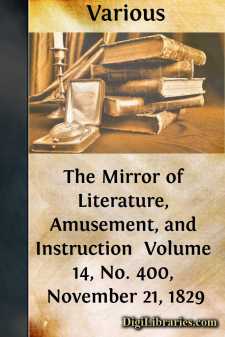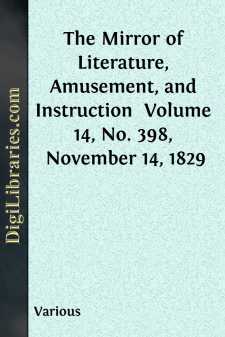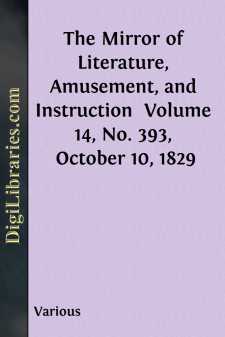Periodicals
- Art 27
- Children's periodicals 59
- Entertainment 5
- Food/Wine 2
- Games/Humor 455
- General 661
- Health 1
- History 53
- House/Home 1
- Regional 62
- Science/Nature 118
- Transportation 10
Periodicals Books
Sort by:
by:
Various
ST. DUNSTAN'S, FLEET STREET. No church in London is perhaps better known than the above, which is distinctively called Saint Dunstan's in the West. External elegance has little to do with this celebrity, which has been acquired by the two wooden figures placed on a pediment in front, representing savages, who indicate the hours and quarters by striking a bell with their clubs: this has caused...
more...
by:
Various
Burleigh, Northamptonshire. The above is a view of the grand screen and entrance lodges to Burleigh, or Burghley, the seat of the Cecil family, and now the property of the Marquess of Exeter. The house and principal part of the demesne, are within the parish of Stamford St. Martin, in the church of which are some costly monuments to several eminent persons of the Cecil family; and this estate gave...
more...
by:
Various
TUNBRIDGE WELLS. With sketches of Dr. Johnson, Cibber, Garrick, Lyttleton, Richardson, &c. &c. For Explanation, see the annexed page. References to the Characters in the Engraving. 1. Dr. Johnson.—2. Bishop of Salisbury (Dr. Gilbert.)—3. Lord Harcourt.—4. Cotley Cibber.—5. Mr. Garrick.—6. Mrs. Frasi, the singer.—7. Mr. Nash.—8. Miss Chudleigh (Duchess of Kingston.)—9. Mr. Pitt...
more...
by:
Various
HAMPTON COURT. Here is a bird's-eye view of a royal palace and domain "cut out in little stars." It is copied from one of Kipp's Views in Great Britain in the time of Queen Anne, and affords a correct idea of Hampton Court in all its olden splendour. The palace is situated on the north bank of the Thames, two miles west from Kingston. It was magnificently built by Cardinal Wolsey....
more...
by:
Various
MR. GURNEY'S IMPROVED STEAM CARRIAGE. Mr. Gurney, in perfecting this invention, has followed Dr. Franklin's advice—to tire and begin again. It is now four years since he first commenced his ingenious enterprise; and nearly two years since we reported and illustrated the progress he had made. (See MIRROR, vol. x. page 393, or No. 287.) He began with a large boiler, but public prejudice was...
more...
by:
Various
SION HOUSE. SION HOUSE. Taylor, the water poet, or Samuel Ireland, the picturesque Thames tourist, could not, in all their enthusiasm of jingling rhymes and aquatint plates, have exceeded our admiration of Sion House. Its whitened towers and battlemented roof are known to all the swan-hopping and steam navigators of our day, and none who have floated To where the silver Thames first rural grows,— can...
more...
by:
Various
The Limoeiro, at Lisbon. Locks, bolts, and bars! what have we here?—a view of the Limoeiro, or common jail, at Lisbon, whose horrors, without the fear of Don Miguel in our hearts, we will endeavour to describe, though lightly—merely in outline,—since nothing can be more disagreeable than the filling in. For this purpose we might quote ourselves, i.e. one of our correspondents, or a host of...
more...
by:
Various
THE NATURALIST. Castles, cathedrals, and churches, palaces, and parks, and architectural subjects generally, have occupied so many frontispiece pages of our recent numbers, that we have been induced to select the annexed cuts as a pleasant relief to this artificial monotony. They are Curiosities of Nature; and, in truth, more interesting than the proudest work of men's hands. Their economy is much...
more...
by:
Various
Glammis Castle Here is a castellated palace, or princely castle, associated with many great and daring events in the roll of Scottish history. It stands in the valley of Strathmore, in a park of 160 acres, a little to the north of Glammis, a village of Angus, N.B. The original foundation is of high antiquity; for Malcolm II. was assassinated here in the year 1034, and the chamber in which he expired is...
more...
by:
Various
CLIFTON. Clifton is the Montpellier of England, and is associated with all that is delightful in nature: of this, the Engraving before us is a true picture, whether we contemplate the winding Avon; the sublime beauty of its rocks— Clifton's airy rocks, (as Mr. Bowles poetically calls them), the picturesque scenery of the opposite shore; or the abodes of cottage comforts which cluster into a...
more...


